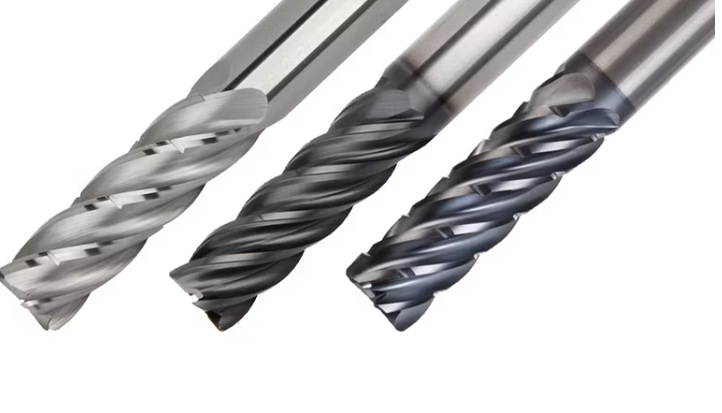最先端:超硬エンドミルが材料除去を再定義する方法
炭化タングステン エンドミル は、切削工具技術の最高峰として、さまざまな業界のメーカーがかつてないレベルの精度、効率、工具寿命を達成することを可能にしています。非常に硬く、耐摩耗性に優れた超硬合金をチップに使用したこの高性能工具は、焼入れ鋼やエキゾチック合金から複合材料、さらには骨に至るまで、さまざまな材料の加工に不可欠です。この包括的なガイドでは、超硬エンドミルの構造、用途、利点、および最適な結果を得るために考慮すべき主な要因を掘り下げながら、超硬エンドミルの複雑さを探ります。

鋼を超える:超硬エンドミルの解剖学を理解する
コンポーネントとコンフィギュレーション構造を詳しく見る
- カッティングエッジ: 工具の心臓部であり、効率的な材料除去のために特定の形状に精密に研磨された複数のフルート(切れ刃)を備えています。フルートの構成は用途によって異なり、ストレート、ヘリカル、特殊な作業用の複雑な形状などのオプションがあります。
- シャンク: 円筒部分は、フライス盤のツールホルダーによって確実に保持され、作業中の安定性と正確な位置決めを保証します。一般的なシャンクタイプには、ウェルドン、ホイッスルノッチ、ストレートシャンクがあり、それぞれに特有のクランプ機構があります。
- 基質: 切れ刃は通常、最高の硬度と耐摩耗性を持つ超硬合金で作られているが、工具本体(基板)は異なる材料で構成することができる:
- ソリッドカーバイド: 要求の厳しい用途に最高の剛性と性能を提供するが、割高なコストがかかる。
- 超硬ハイス: コストパフォーマンスに優れた高速度鋼(HSS)ボディに、ろう付けされた超硬チップを組み合わせ、切削性能を向上。
- コーティング: タングステンカーバイトエンドミルは、その能力をさらに高めるため、高度な蒸着技術を用いた特殊コーティングが施されています。これらのコーティングは、工具寿命を向上させ、仕上げ面粗さを改善し、切削速度を向上させます。一般的なコーティングオプションは以下の通りです:
- 窒化チタン(TiN): 硬度と耐摩耗性を高め、独特のゴールドカラーを提供。
- 炭窒化チタン(TiCN): TiNよりもさらに高い硬度と耐摩耗性を持ち、濃い灰色や黒色を呈することが多い。
- 窒化アルミニウムチタン(AlTiN): 卓越した耐熱性を備え、高速加工や難削材に最適。
混乱を切り開く超硬エンドミルの種類と用途
荒削りから仕上げまで:作業に適した工具の選択
| エンドミル・タイプ | 特徴 | アプリケーション |
|---|---|---|
| スクエアエンドミル | - フラットカット・エンド、90度コーナー<br> - 四角い肩、溝、ポケットを作る | 汎用フライス加工、溝加工、ポケット加工 |
| ボールエンドミル | - 半球状の刃先<br> - 丸みを帯びたエッジ、輪郭、3D形状の作成 | 金型製作、型彫り、輪郭加工、彫刻 |
| コーナーラジアスエンドミル | - 指定した半径で角を丸くする<br> - スクエアエンドミルとボールエンドミルの特徴を併せ持つ | 面取り、R付け、サーフェスのブレンド、フィレットの作成 |
| ラフィングエンドミル | - アグレッシブな材料除去のための少なく深いフルート<br> - 高い金属除去率に最適化 | 大量の材料を素早く除去する粗加工 |
| 仕上げ用エンドミル | - 繊細な表面仕上げのための、より浅いフルート<br> - 軽切削と精密な公差用に設計 | 滑らかな表面と厳しい公差を実現する仕上げ作業 |
| ハイヘリックスエンドミル | - 切り屑排出を向上させるアグレッシブなヘリックス角度<br> - 深いカットや難しい素材に最適 | 高速加工、深いポケット、難削材 |
| ドリルミル | - ドリル加工とフライス加工を1つの工具で実現<br> - 穴あけ用センター刃を装備 | ドリル加工とプロファイル加工、工具交換の削減 |
超硬エンドミル市場:高まる性能要求
タングステンカーバイトエンドミルの世界市場は、以下のような要因によって大きな成長を遂げている:
- 自動化の進展: CNC加工とオートメーションの台頭により、厳しい生産環境に耐えうる高性能切削工具が求められています。
- 航空宇宙と医療の進歩: 成長する航空宇宙産業や医療産業は、チタンやコバルトクロム合金のような軽量で高強度な材料の精密加工を必要としている。
- 小型化のトレンド: 電子機器、医療機器、その他の分野では、より小さく、より複雑な部品が求められており、超硬合金が得意とする微細加工能力が必要とされている。
切削工具技術のグローバルリーダー:比較分析
| サプライヤー | 所在地 | 価格帯(1個あたり、概算) | 特産品 |
|---|---|---|---|
| サンドビック・コロマント | スウェーデン | $20 – $200+ | 高性能超硬材種、革新的な工具設計、持続可能性の重視 |
| ケナメタル | アメリカ | $18 – $180+ | 豊富な製品ポートフォリオ、多様なコーティングオプション、業界固有のソリューション |
| TRUER | 中国 | $16 – $170+ | 切りくず排出を最適化する先進の形状、高効率加工ソリューション |
| 三菱マテリアル | 日本 | $17 – $190+ | 高品質の超硬基板、高度なコーティング技術、精密さへのこだわり |
注: 超硬エンドミルの価格は、エンドミルのサイズ、タイプ、材質、コーティング、数量、その他の要因によって大きく異なる場合があります。比較のため、常に複数のサプライヤーに見積もりを依頼するのがベストです。
利点を天秤にかける超硬エンドミルの利点と限界
情報に基づいた機械加工の決定:長所と短所
| 特徴 | メリット | 制限事項 |
|---|---|---|
| 硬度と耐摩耗性 | - 卓越した硬度により、最も硬い材料の加工が可能<br> - 高い耐摩耗性により工具寿命を延ばし、工具コストを削減 | - 脆く、強い衝撃や不適切な使用で欠けたり割れたりすることがある。 |
| 切削速度と送り速度 | - ハイス工具に比べ、大幅な高速切削が可能<br> - 材料除去率の向上による生産性の向上とサイクルタイムの短縮 | - 振動を最小限に抑え、工具の損傷を防ぐために、厳密なセットアップと機械が必要。 |
| 精度と表面仕上げ | - 厳しい公差と微細な表面仕上げが可能<br> - 二次的な仕上げ作業の必要性を削減または排除し、時間とコストを節約する。 | - 初期コストはハイス工具より高くなることがあるが、工具寿命の延長と性能の向上により相殺されることが多い。 |
刃先を越えて: エンドミルの性能に影響を与える要因
加工作業の最適化:主な検討事項
- 素材の互換性: 加工する材料に応じて、適切な超硬材種、コーティング、および形状を選択することは、工具寿命、切削性能、および仕上げ面にとって極めて重要です。
- 切断パラメータ: 効率的で効果的な加工には、工具と材料の特性に基づいて、切削速度、送り速度、切り込み深さを最適化することが不可欠です。切削データチャートを参照するか、ソフトウェアを使って計算する。
- クーラントの選択: 適切なクーラント塗布は、熱の制御、切削ゾーンの潤滑、切屑排出の改善に役立ち、これらすべてが工具寿命の延長と仕上げ面の向上に貢献します。
- マシンの剛性: 超硬エンドミル、特に超硬ソリッドエンドミルは、工具のたわみや破損を防ぐため、振動を最小限に抑えた剛性の高い機械で最高の性能を発揮します。適切なワーク把持と機械のメンテナンスが不可欠です。
TRUERを選ぶ理由
- 妥協のない品質: 最高級のタングステンカーバイド材料を調達し、製造工程全体で厳格な品質管理を行うことで、すべてのエンドミルが最高基準を満たしています。
- アプリケーションの専門知識: 当社のエンジニアチームは、材料、公差、希望する結果を考慮し、お客様の特定の加工ニーズに最適なエンドミルを選択するための専門的なガイダンスを提供します。
- カスタマイズ能力: 特殊な形状、コーティング、サイズなど、ユニークなアプリケーション要件を満たすカスタム設計ソリューションを提供します。
- カスタマー・サクセスへのコミットメント: 私たちは、お客様との永続的なパートナーシップの構築に努め、卓越したサポートと技術支援を提供し、お客様の加工を成功に導きます。
よくある質問機械加工に関するお問い合わせ
1.用途に合った超硬エンドミルの選び方は?
加工する材料、要求される公差、表面仕上げ、希望する金属除去率、利用可能な機械能力を考慮してください。当社の技術エキスパートにご相談いただくか、アプリケーションの詳細をお知らせください。
2.エンドミルの摩耗の典型的な兆候と、工具寿命を最大限に延ばす方法は?
摩耗の兆候には、切削抵抗の増加、仕上げ面の劣化、切り屑の溶着、加工中に聞こえる変化などがある。工具寿命を最大限に延ばすには、切削パラメータを最適化し、クーラントを適切に塗布し、工具の過度な張り出しを避け、工具が摩耗していないか定期的に点検することである。
3.特注形状やコーティングの超硬エンドミルはできますか?
はい、カスタムメイドのソリューションを専門としています。エンドミルの形状、コーティング、サイズをお客様の加工要件に合わせてカスタマイズすることができます。当社のエンジニアリングチームにご相談ください。
4.TRUERのカスタム超硬エンドミルを注文する際のリードタイムはどのくらいですか?
リードタイムは、デザインの複雑さ、注文数量、現在の生産能力によって異なります。ご要望があれば、当社の営業チームが個別にリードタイムの見積もりをいたします。
5.TRUERは、超硬エンドミルの選定や最適化に関する技術サポートやコンサルティングサービスを提供していますか?
もちろんです!当社の経験豊富なエンジニアチームが、材料選択のガイダンス、切削パラメータの最適化、トラブルシューティングの支援など、包括的な技術サポートを提供いたします。お客様の具体的な課題についてのご相談や、コンサルテーションのご予約は、こちらまでご連絡ください。




